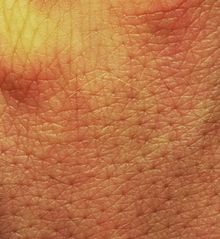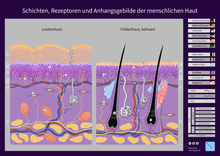Skin
![]()
The title of this article is ambiguous. For other meanings, see Skin (disambiguation).
![]()
This article describes the outer enveloping organ. For the protective layer inside the body, see mucosa.
The skin (ancient Greek δέρμα derma; Latin cutis) is functionally the most versatile organ of a human or animal organism.
As an enveloping organ, it serves to separate the inside from the outside, to protect against environmental influences and to maintain homeostasis (inner balance). Furthermore, the skin assumes essential functions in the area of metabolism, heat regulation and the immune response; it has a variety of adaptation and defense mechanisms.
Furthermore, the skin represents the largest organ of sensory perception in terms of area, that of surface sensitivity. The mechanoreceptors of the skin include numerous different sensory cells for touch, pressure or vibration as qualities of the sense of touch. Thermoreceptors convey sensations of warmth or cold, nociceptors the sensation of pain.
Skin contacts in body contact are not only vital for young mammals and carry actual social bonds. In addition, paleness or reddening and swelling of certain skin areas due to altered skin blood flow can represent special signals in intraspecific communication.
To be distinguished from this are arbitrarily produced skin changes of various kinds in humans; they can be used as a sign of social affiliation or demarcation and serve a self-portrayal. The skin thus becomes a representatively designed surface for one's own or others' glances.
Diseases originating from the skin or symptoms related to the skin are called dermatogenic.

Structure of human skin

Close-up of human skin (here field skin) .
Etymology
The old Germanic word mhd., ahd. hūt ("skin, integument, epidermis, membranous structure, meninges, fur") belongs to the idg. root [s]keu- extended with t "cover, envelop" and thus means "cover".
Structure of the human skin
The thickness of human skin is 1.5 to 4 mm. The body surface (skin area) of adult humans is on average 1.73 m². It weighs about 10 to 14 kg.
Layers/components of the skin
The outer skin is divided into three main layers: Epidermis (epidermis), Dermis (dermis, lat. Corium) and Subcutis (hypodermis). The epidermis and dermis together form the cutis.
Epidermis
The epidermis belongs to the epithelial tissues. It is a multilayered keratinizing squamous epithelium that is usually between 0.03 and 0.05 millimeters thick. On the palms of the hands and the soles of the feet, the horny layer is up to several millimeters thick and is colloquially called "callus" (see also horny callus).
The following layers are distinguished from the outside to the inside:
- Horny layer (stratum corneum)
- Luster layer (stratum lucidum) (is only present on the groin skin of the inner sides of the hands and feet)
- Granule cell layer (stratum granulosum)
- Spiny cell layer (stratum spinosum)
- Basal layer (stratum basale)
The prickle cell layer and basal cell layer together form the germinal layer (stratum germinativum).
Dermis (dermis, corium)
The dermis consists mainly of connective tissue fibres and serves to nourish and anchor the epidermis. Here the finely capillarized blood vessel system supplies the border zone to the epidermis. The lower dermis contains the smooth muscles and blood vessels that are important for temperature regulation.
The dermis is divided into a stratum papillare (papillary layer, cone layer, papillary body) and a stratum reticulare (reticular layer).
Skin appendages
The skin appendages include various structures such as the scales of reptiles, the feathers of birds, the hair of mammals and other skin-derived structures such as horns, nails, claws and hooves, the substance of which also consists essentially of keratins.
In addition to these structures, skin glands are also included, which open at the epidermis and are anchored in the dermis. In humans, these include sebaceous glands, eccrine sweat glands and scent glands; the mammary gland is a specialized skin gland. The hair-bellows muscle, Musculus arrector pili, which raises a hair, is also an appendage of the skin; contractions of the hair-bellows muscles lead to goose bumps in humans, and in the case of echinoderms they make their hair coat an effective defensive weapon.
Subcutis
The subcutis (or hypodermis) forms the base for the overlying layers of skin and contains the larger blood vessels and nerves for the upper layers of skin, as well as the subcutaneous fat and loose connective tissue. Sensory cells for strong pressure stimuli, for example the lamellar corpuscles, are located in the subcutis.
Surface structure of the skin
If you look at the skin more closely or with a magnifying glass, a fine relief becomes visible. According to this, the skin is divided into two types.
Inguinal skin
Inguinal skin occurs on the fingers, the inside of the hand (palmar) and the sole of the foot (plantar). The epidermis here shows fine papillary lines (skin ridges), which are formed by the dermal papillae being arranged in longitudinal rows. Each dermal ridge is underlain by two rows of papillary bodies. The dermal ridges form an individual pattern of various geometric figures (whorls, arches, loops, double loops). These patterns are used forensically in dactyloscopy (fingerprint recognition) as a form of biometric data. The skin of the groin does not contain any skin appendages, except for many sweat glands.
Field skin
Field skin covers the remaining skin areas. Here the surface shows rhombic fields delimited by fine furrows (areolae cutaneae). The furrows are formed on the epidermal areas that are free of papillae and disappear when the skin is under greater tension. They serve as reserve folds because the epidermis is less stretchable than the dermis. The size of the dermal fields varies with the region of the body. The field skin contains the skin appendages and is less than 0.1 mm thick. It is thinnest in the region of the eye and the genital organs.

Optical coherence tomography of the fingertip (groin skin) in vivo with sweat gland excretory ducts

The human skin shows regional differences in layer thickness, receptors and skin appendages - e.g. hairless skin of the fingertip compared to hairy skin of the back of the hand.
Search within the encyclopedia